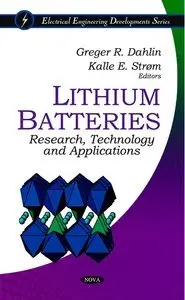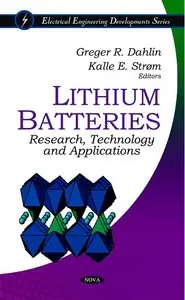Greger R. Dahlin and Kalle E. Strom, "Lithium Batteries:: Research, Technology and Applications"
2010 | ISBN: 1607417227 | 226 pages | PDF | 6 MB
2010 | ISBN: 1607417227 | 226 pages | PDF | 6 MB
Lithium ion batteries, a class of chemical power sources that use an electrochemical process of lithium ion intercalation into or de-intercalation from host materials, are gaining dominance in mobile electronic applications, and are also showing promise for an upcoming new generation of electric vehicle applications. Since Sony Corporation commercialised rechargeable lithium-ion batteries, the batteries have been widely utilised as the power sources in a wide range of applications, such as mobile phones, laptop computers, digital cameras, electrical vehicles, and hybrid electrical vehicles. This book is concerned with the recent developments in and research of LiFePo4 cathode materials with an emphasis on the synthesis method and how to improve electrochemical performance. Moreover, the efforts made to develop other new inorganic cathode materials for a new generation of lithium ion batteries are reviewed. A systematic semi-empirical way to analyse the constituents of total cell impedance in lithium-ion battery is also presented. In addition, overcharge protection is not only critical for preventing the thermal runaway of lithium-ion batteries during operation, but also important for automatic capacity during battery manufacturing and repair. This book compares three overcharge protection strategies - external circuit protection, inactivation agents, and redox shuttles - to highlight the advantage of redox shuttles for overcharge protection. The safety of lithium-ion battery packs are also discussed, as well as techniques for studying thermal stability, such as differential scanning calorimetry and accelerating rate calorimetry.



